On-page SEO is one of the most important processes you can use for achieving higher rankings in a search engine’s organic results and running successful SEO campaigns.
A website is the focal point of all SEO processes and if it’s not properly optimized for both search engines and users, you minimize your chances of getting traffic from search engines.
In this post you’ll learn everything there is to know about on-page SEO. Follow these tips every time you publish a new post and improve your search engine rankings.
- What is On-Page SEO?
- On-Page SEO Techniques
- On-Page SEO Checklist
- Is On-Page SEO More Important Than Off-Page SEO?
What is On-Page SEO?
On-page SEO (sometimes referred to as on-site SEO), is the process of optimizing the structure and content of a webpage. The ultimate goal of on-page SEO is to speak the ‘search engines’ language’ and help search engine crawlers understand the meaning and context of your pages.
Why is on-page SEO important?
On-page SEO is important because it provides search engines with a number of signals to help them understand what your content is about.
During the indexing and ranking processes, search engines try to associate webpages with keywords and search terms users type in the search box.
It’s through on-page SEO elements that you can guide them as to which keywords you want your pages to rank.
THE COMPLETE SEO COURSE
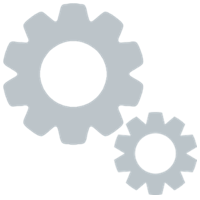
- SEO Full Course
- Become an SEO expert
- Increase your traffic in 60 days or less
- Trusted by more than 3000 students
In addition, it is called ‘on-page’ because any optimization changes made to a webpage contribute to better user experience.
On-site SEO is a subset of SEO. Take a look at the diagram below and notice how On-Page SEO intercepts with technical SEO and Off-Page SEO.
All three processes have to work together to get the best possible outcome, but the main job of on-site SEO is to optimize the content and structure of a particular page.
What is SEO?
Search Engine Optimization is a general term that includes everything you need to do to improve your website’s ranking positions in the top search engines.
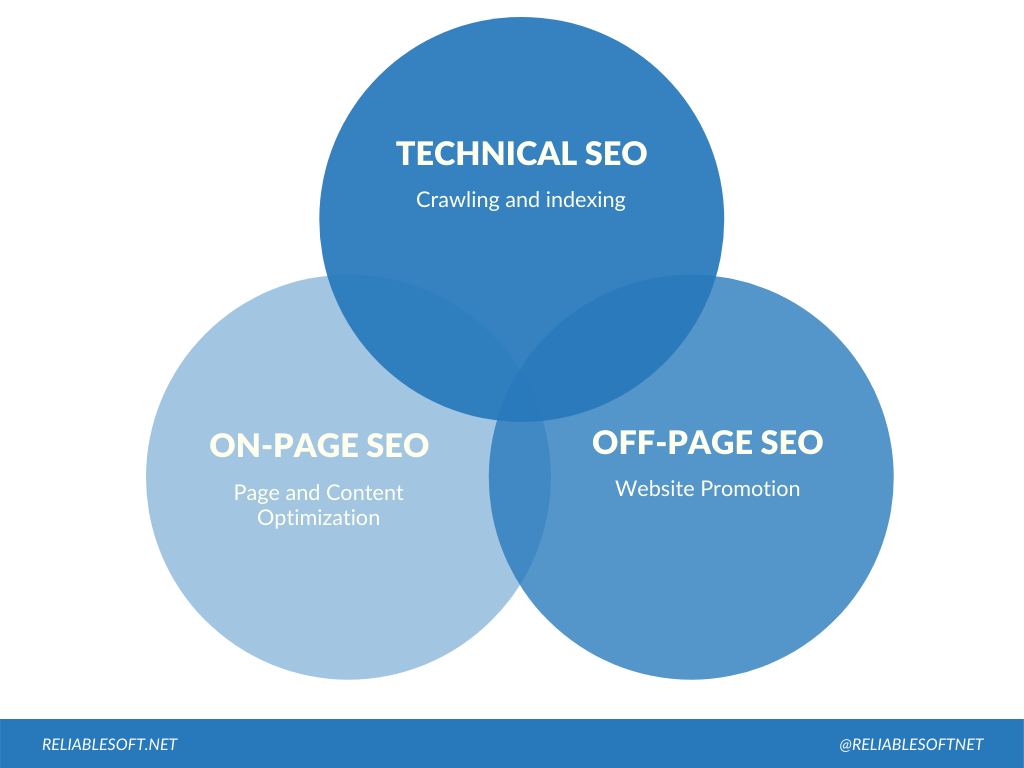
This includes optimizing your website for the crawling and indexing phase (that’s technical SEO). Optimization settings you can apply to your pages and content (that’s on-page SEO) and techniques you can use outside the boundaries of the website (that’s off-page SEO).
What is Off-Page SEO?
Off-page SEO is about link building and other signals you can give to search engines to convince them about the quality and usefulness of your website.
It has to do with promotion methods outside the boundaries of your website.
11 On-Page SEO Techniques for Higher Rankings
Now that the theory about SEO and the importance of on-page SEO is justified, let’s move on to the practical part.
Some people can argue that there are more on-page SEO techniques and not only 11, but these are the most important you can apply to your website today and quickly boost your SEO.

Here is a summary of all on-page SEO techniques:
- Publish high-quality content
- Optimize page titles and meta descriptions
- Optimize page content
- Headings and content formatting
- SEO Images and other multimedia elements
- URL optimization
- Internal links
- External links
- Page loading speed
- Mobile-friendliness
- Comments and on-page SEO
1. Publish High-Quality Content
When dealing with SEO, you always need to have in mind the following:
A website with brilliant content can do great with or without SEO. A website with bad content will not survive with or without SEO. A website with good content can become even better with SEO!
So, what is considered good content?
Original content (articles, text, images, videos, presentations, infographics, comments, etc.) – No copies or rewrites of existing articles.
Content exclusive for your website – Even if it’s your own content, if you have already published it on another website then it’s not good for your site (unless you specify the canonical tag correctly).
Content that includes text elements – Write text to accompany your non-text content. For example, if you post videos on your website try to add a text description as well. If you add images try to describe in words what the image is all about.
Content that is useful – Don’t publish content for the sake of publishing. Before hitting the publish button make sure that what goes live adds value to your website and readers.
Content that is well researched – Users don’t want to read quickly prepared posts and neither do search engines.
Long articles are proven to rank better than short articles.
Unbiased content – If you are writing about a certain topic or answering a question make sure that what you write is justified and covers both sites of a story.
2. Optimize Page Titles and Meta Descriptions
This is SEO 101 but very important for on-page SEO. When search engines ‘read’ your pages, among other things, they check the page title and the description of a page.
They do so because they need to understand what the page is all about and then based on other factors (off-page SEO, domain authority, competition, etc.), they will rank your page (for various keywords) in a position in their index.
Hint: If you are not familiar with this process, spend a few minutes and learn how search engines work.
Page titles

Each page must have a unique title that will help both search engines and users understand what the page is about.
A page with the title “SEO Tips for Beginners” is better than a page with the title “index.html”.
The page title was and still is one of the most important on-page SEO factors.
Page title optimization Tips
Add keywords to the beginning of your page titles – When possible add your target keywords to the beginning of your page title. This helps search engines understand right from the beginning what keywords the page is targeting.
That does not mean you should cross the line and start doing keyword stuffing. If you cannot have a keyword at the beginning then it’s not the end of the world. Just make sure that your target keyword is part of the title.
Write short and descriptive titles – A page title doesn’t have to be very long. The general recommendation is to keep it below 60 characters because this is the average amount of characters displayed by Google in the search results.
Include numbers and power words – Having numbers in the title as well as power words like “Ultimate, actionable, amazing, checklist, etc.”, make titles more interesting and this increases their CTR (Click Through Rate).
No need to include your domain in the title – There is no need to include your domain name in the title because this is added automatically by Google. You can make use of the 60 characters to provide an accurate description of the page.
An exception to this rule is when you have a strong brand that people can easily recognize, in this case, you can consider having your domain in the title.
For more optimization tips read Page titles optimization and SEO best practices.
Meta Descriptions

The page description is what the searcher will see in the search engine results page (SERPS). It has to be descriptive, up to 200 characters and unique for each page.
It’s your opportunity to advertise your page and convince users to click your link and visit your website rather than selecting one of the other links.
It should be noted that Google does not always show the meta description provided, but many times they use an automated description if they believe is more useful for the searcher.
Meta description Optimization Tips
Avoid auto-generated descriptions – Even though Google may not use your description, it’s always a best practice to avoid using auto-generated descriptions that sometimes don’t make sense.
Add your target keyword(s) in the description – Google still highlights the search terms both in the title and description so adding your target keywords, makes descriptions more relevant and appealing to the searcher.
To learn more about how to optimize your meta descriptions for SEO, read our study on the meta description length.
3. Optimize Page Content
Content SEO is part of on-page SEO and has to do with optimizing the actual content for your target keywords.
Before publishing a piece of content (whether this is text, images, audio or video), the first step is to do your keyword research.
This is necessary to find out what search terms users are typing in the search box and create content that can satisfy their intent.
Once you decide on your target keywords, you should create a list of related keywords (also called LSI keywords), longtail keywords and use them in your titles, descriptions, headings and page content.
Why? Because with the introduction of Rank Brain, Google search algorithms have become more intelligent and besides keyword relevancy in content, they are also looking for topic relevancy.
This means that in order to make your content more relevant to broad topics, you need to enrich your content with LSI keywords.
There are various ways to find out which keywords are considered by Google to be relevant to your target keywords.
The easiest and fastest way is to take advantage of three features provided by Google: Google suggest, People also ask for and Related Searches.
Google suggest
When you start typing a query in Google search, you are presented with a list of possible phrases to use in your search. These are great keyword candidates to mention in your content.
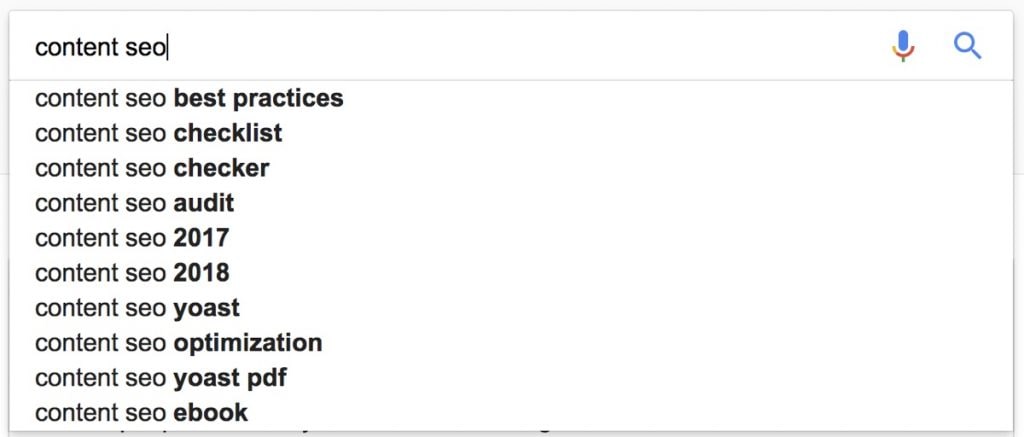
People Also Ask
When you click search, Google shows you the results and among them, a section called “People also ask”. These are good candidates to use in your sub-headings.

Related Searches
At the bottom of the search results, Google shows you a list of related searches.
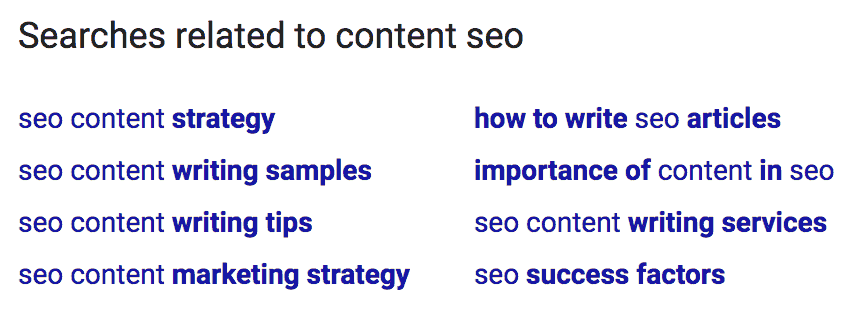
All you have to do is that you mention some of the above words in your content (without doing keyword stuffing).
4. Headings and Content Formatting
A page needs to be properly formatted. Think of it as a report which needs to have a heading (h1) and subheadings (h2, h3).
The H1 Tag
Each page needs to have only one H1 tag. If you are using WordPress then by default the title of a page is wrapped into H1 tags.
You can either choose to have the same <title> and <h1> tag or provide an alternative title for the heading.
Remember that search engines display in the results what they find in the title tag and not the h1 tag. There are cases where you want to differentiate the two, like the example below:
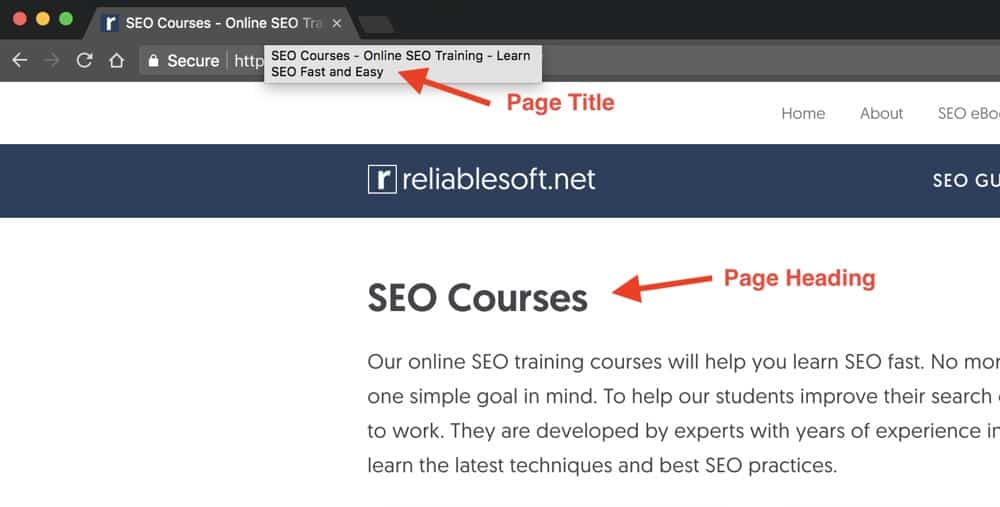
As far as the other headings are concerned (h2, h3), the things you need to have in mind are the following:
- Avoid using a single word for a heading but make your headings interesting and useful for users that like to skim read an article.
- Use headings hierarchically i.e. the first heading tag is the <h1> and then the <h2> and then <h3>, <h4> etc.
- The subheadings are a great place to use related keywords in your content.
Further Reading: What is the H1 Tag
Content Formatting
Do not just throw text on a page but make sure that it is readable.
- Use bold, underline or italics to highlight the important parts of a page.
- Use a good size font (at least 14px).
- Split the text into small paragraphs (max 3-4 lines).
- Use enough spacing between the paragraphs to make the text easier to read.
- Make use of CSS to create sections that stand out and break the text into smaller more manageable parts.
5. Images and Other Multimedia Elements
Images are important for presentation purposes. They make a page more interesting and easier to understand.
The biggest problems with images are that search engines don’t understand them and that they add to the loading speed of a page.
Best practices for SEO optimizing images
- Use original images. If you need to use an existing image from the web you need to reference the source.
- Optimize the size of the images – the smaller the size (in bytes) of the image the better.
- Use an ALT tag to describe the image – This helps search engines understand what the image is about.
- Use descriptive filenames – Don’t just name your image ‘image1.jpg’ but try to use descriptive filenames, for example, ‘man-doing-push-ups.jpg’.
- Use a Content Delivery Network – If you have a lot of images on a single page you can use a CDN service that will make your page load faster. In simple terms, your images will be hosted and served by a number of servers and this speeds up the loading process.
6. URL Optimization
Optimizing your URLs is important for maximum SEO. It has two parts. The first part is URL optimization and the second is URL structure.
NOTE
Some SEO Courses, including our Complete SEO Course, have URL optimization as part of “Technical SEO” but it’s also strongly related to On-Page SEO, that’s why it is mentioned here.
If you take a look at the SEO Overview diagram (above), URL optimization is in the common area between technical and on-page SEO.
URL Optimization

A permanent link (also known as a slug) is the unique URL of each page.
Good URLs should be less than 255 characters and use hyphens to ‘-‘ separate the different parts.
Just like the page title, an SEO friendly URL is short, descriptive and includes your target keyword.
These are some examples of good URLs:
- https://www.reliablesoft.net/diy-seo-tutorial-for-beginners/
- https://www.reliablesoft.net/seo-tools
- https://www.reliablesoft.net/search-engine-marketing/
These are examples of bad URLs:
- https://www.reliablesoft.net/p?165 or
- https://www.reliablesoft.net/seotipsforbeginners/ or
- https://www.reliablesoft.net/123131/publish/data2/seo_Tips.html
Further Reading: How to create SEO Friendly URLs
URL Structure
The URL structure should mimic the actual structure of a website.
Best practices for optimizing your URL structure
Make use of categories – Group your pages into categories to help users and search engines find what they want faster.
It’s like having a warehouse with lots of uncategorized items versus a warehouse with all the items assigned to a dedicated category.
You can have sub-categories as well but my advice is not to go over two levels. For example, a good category structure is:
Homepage > Social Media > Facebook > Article
and not
Homepage > Social Media > Facebook > How To > Article
Add a Breadcrumb menu– A breadcrumb is helpful because it allows users to navigate your website in a structured way since they always know where they are and how far from the home page.
Further Reading: How to optimize your site structure
7. Internal Links
Linking to pages within your website is very important for SEO because:
It’s like building your own web
The first step a search engine spider will do once they discover a page, is to follow the links they find on that page (both internal and external links).
So, when they arrive at your page, if you don’t have any other links within the text they will read your page and go.
If you have links pointing to other pages within your website they will take those into account as well.
It’s a way to let search engines know about your other pages
As explained above when search engines find a page with links, they will go and read those pages too, so you can use this technique to tell search engines about pages of your website they have not yet discovered.
It’s a way to tell search engines which your most important pages are
Every website has some pages that are more important than others. Internal linking is one of the ways to pinpoint the most important pages by sending them more internal links.
It’s a way to increase the users spend on your site
A user that is reading your post is more likely to click on a link to read more about a certain topic and thus increase both the time spend on your website, number of pages per visit and decrease the bounce rate.
- Don’t use keywords only for your internal links
- Add internal links when they are useful for your reader
- No more than 15 internal links per page (this is my opinion and not based on any research or studies)
- When possible, add the links in the main body of your webpage (not in the footer or sidebar)
8. External Links
After the release of Panda and Penguin, a lot of webmasters are afraid to link to other websites. They believe that this will trigger a Google penalty but this is wrong.
By linking to other high-quality related websites, you increase the trustworthiness of your content and this is good for SEO.
Also, Google can use external links as a way to understand more about the topics you are covering in your content.
9. Page Loading Speed
Last but not least, 2 SEO techniques that are becoming more and more important are: speed and mobile-friendliness.
Page Loading Speed
Google is investing a huge amount of money to make the web faster. In every Google, I/O someone will talk about the importance of speed and their desire to include the fastest websites in their index.
In order to ‘force’ web site owners to take speed into account, they have officially added speed as one of the known ranking factors.
So, we know for sure that website speed does matter when it comes to SEO and ranking.
As a webmaster, your job is to make sure that your website loads as fast as possible by taking into account Google’s recommendations. Having fast-loading websites is not only good for SEO but for customer retention and conversions.

10. Mobile Friendliness
Almost 60% of the searches in Google are now coming from mobile devices. This means that if your website is not mobile-friendly, you are already losing half of the potential traffic.
What should you do?
As a first step, make sure that your website is mobile-friendly. Check your website with the Google mobile friendly tool and fix any potential problems.
Then go one step further and test your website on mobile, like a real user would do, and make sure that everything is displayed correctly including your CTA buttons.
In general websites with a responsive design, have nothing to worry about mobile-friendliness.
11. Comments and On-Page SEO
Many people believe that with the rise of social media blog comments are no longer important, but they are wrong.
Blog comments are still important. As stated by Google’s Gary Illyes, it’s an indication that people like your content and interact with the page and this can really boost your SEO.
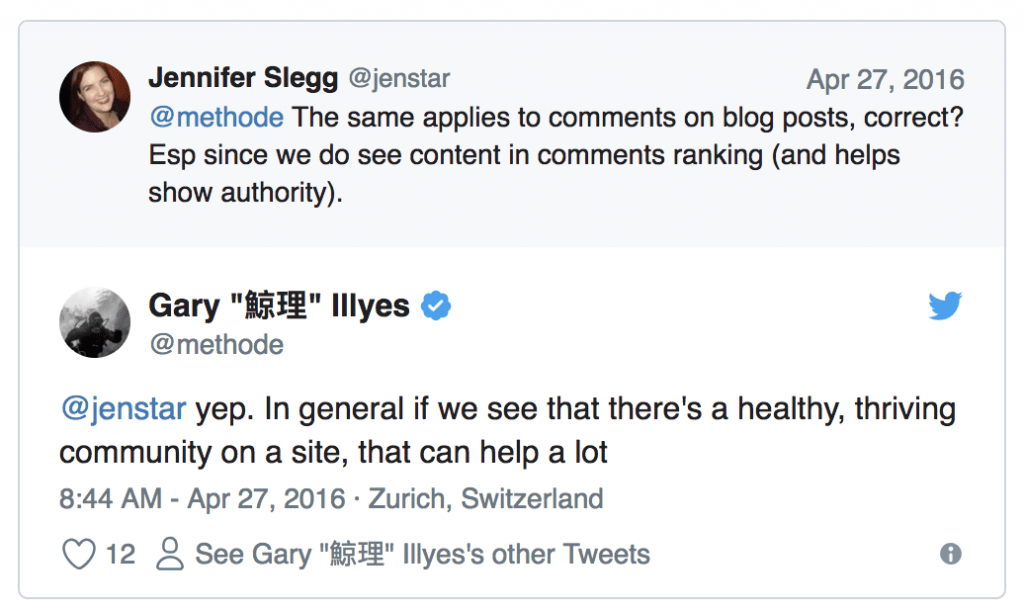
Users before posting a new comment will most probably read the existing comments and this is an additional way to increase the time they spend on the page and your website.
To make the best use of comments, follow these simple rules:
- Always moderate comments before publishing
- Avoid publishing comments that are too general
- Only approve comments that are relevant to the page content and add value
- Don’t approve comments when users don’t use a real name
- Always reply to comments, this will encourage more people to comment.
On-Page SEO Checklist
If you have read the article up to this point, the main tips are summarized in the checklist below.
- Make sure that you understand the difference between on-page SEO and off-page SEO.
- Make sure that your content is original, useful and well researched.
- Review and optimize your page titles by adding keywords, power words and numbers.
- Provide for a unique meta description for all your pages (include your target keywords).
- Perform keyword research and make sure that your target keywords are part of the title and content.
- Find LSI and related keywords and use them in your headings and content.
- Make sure that your page has only one H1 tag.
- Use headings hierarchically on the page (H1 -> H2 -> H3).
- Beautify your content (use bold, italics and CSS).
- Optimize your images and other multimedia elements (ALT Text is the most important factor for images).
- Make sure your URLs are SEO Friendly and that your URL Structure mimics your site structure.
- Add internal links to your content.
- Add outbound links to your content (link out to high-quality related websites).
- Make sure that your website loads in less than 3 seconds (both desktop and mobile).
- Make sure that your website is mobile-friendly.
- Encourage comments but only publish comments that make sense.
Is On-page SEO More Important than Off-Page SEO?
To achieve maximum exposure in the search engines and keep your users happy you need both off-page SEO and on-page SEO.
On-page SEO is more important (at least for new websites), and I will explain below why.
‘Speak’ the search engines language
It makes more sense to start with on-page SEO and get it right rather than trying to convince search engines to give you better rankings with off-page SEO.
Search engines are computer programs (software) and they don’t ‘see’ a website like a normal user, but they can only understand code and in particular the HTML language.
With SEO and especially on-page SEO, you ‘speak’ their language. Your goal is to help them understand, by giving them various signals through the structure of a page and content optimization, what a page is all about.
The more signals you can give them, the greater are your chances of achieving better rankings.
On-Page SEO is about the user as well
Never forget that your primary goal is to keep your users happy.
Off-Page SEO may bring traffic to the website but if it is not set up correctly or if it is not user-friendly, the results will be disappointing.
Many websites get it wrong
It’s amazing but it is true that the majority of websites today are not optimized for search engines.
Despite the plethora of information about SEO, many website owners believe that it does not worth to try SEO and they quit before starting.
For those cases, on-page SEO has a lot to offer both in terms of usability and also in terms of traffic.
On-Page SEO is sometimes all you need
If you are running a website for small business and you need to get local customers searching for various terms on Google then on-page SEO is all you might need to do.
Off-page SEO comes after On-Page SEO
Before even starting to think about how you can promote your website, you need to ensure that it is optimized and in good condition.
So, the first step is to work with on-site SEO and then go off-site.
For website owners that are new to SEO Trends or simply do not have the time to deal with web site optimization, you can always hire a trusted SEO firm to do the work for you.
Comments
Post a Comment